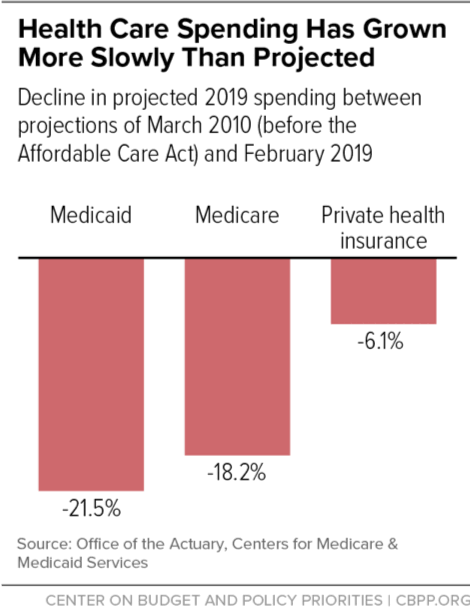BEYOND THE NUMBERS
New projections from the Medicare actuaries provide fresh evidence that the Affordable Care Act (ACA) has helped slow spending growth throughout the nation’s health care sector.
Under the actuaries’ updated projections of national health expenditures, both public and private health spending in 2019 will be substantially lower than what the actuaries projected in March 2010, just before the ACA’s enactment.
Medicaid shows the largest slowdown. In 2010, the Centers for Medicare & Medicaid Services (CMS) projected that Medicaid spending would reach $794 billion by 2019. Today, even with the ACA’s coverage expansions, CMS projects that Medicaid will spend just $623 billion this year or 21.5 percent less. (See figure.)
Medicare and private health insurance have also recorded large reductions. Projected Medicare spending in 2019 is 18.2 percent below what the actuaries projected before the ACA, and projected private health insurance spending is down 6.1 percent.
While the March 2010 projection didn’t include the ACA’s major coverage expansions, a combination of factors have more than offset their cost. These include: (1) the ACA’s reductions in Medicare payment rates to health care providers, (2) changes in health care payment and delivery systems that the ACA and the 2015 Medicare Access and CHIP Reauthorization Act initiated, (3) state efforts to improve Medicaid efficiency, and (4) a continuing health cost slowdown in the public and private sectors that began before the ACA.
The health spending slowdown has greatly improved the long-run federal budget outlook, as we’ve noted. In early 2010 we projected that federal debt would reach 289 percent of gross domestic product (GDP) by 2048; we now project 113 percent of GDP. Over half of that improvement stems from lower health care costs; the rest largely reflects lower interest rates. Although health care costs remain a major driver of future increases in federal spending, that shouldn’t obscure how much their projected costs have fallen in recent years.

